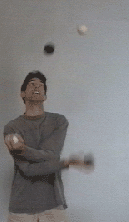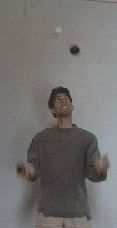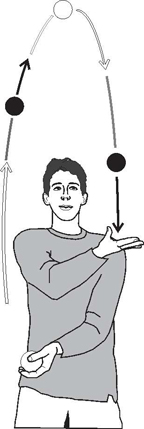Four-Ball Mills Mess: Alternate False Showers

Jack Kalvan demonstrates clockwise Four-Ball False Shower.
The following article first appeared in the May/Jun 2001 issue of JUGGLE magazine. The publisher has kindly given permission to reproduce it here.
Third method to learn the Four-Ball Mills Mess: the Four-Ball False Shower
One method to learn a three-ball Mills Mess is to learn the False Shower in both directions. Repeatedly tossing three throws of a False Shower clockwise, immediately followed by three throws of a False Shower in a counterclockwise direction, gives one Mills Mess.
The same is true for a Four-Ball Mills Mess. Repeating three throws of a clockwise Four-Ball False Shower, followed by three throws of a counterclockwise Four-Ball False Shower, turns into a Four-Ball Mills Mess. Plus, learning a Four-Ball Mills Mess this way also adds Four-Ball False Showers in both directions to your repertoire.
When a good juggler performs a Four-Ball False Shower smoothly, it may appear that all balls fly to all hands. This isn't true, however. The siteswap is 4, and two white balls are always juggled only by the left hand. Of course this means that the two black balls are exclusively handled by the right hand.
The only trouble you may have with this method of learning Four-Ball Mills Mess is that, for many, a Four-Ball False Shower is more difficult to master than Four-Ball Mills Mess. The proximity of all four balls being thrown and caught in the same general area may make distinguishing hands and balls difficult for some people. Without extreme throwing precision, the likelihood of collisions is also quite high.
Clockwise Four-Ball False Shower
For the clockwise Four-Ball False Shower, as in the three-ball clockwise False Shower, your hands alternate between the open and crossed arms positions. One hand always crosses underneath and one hand always crosses on top. While the choice of which hand crosses underneath is up to you, most people will find it easier if the right hand crosses underneath for the clockwise version.
Both the right and left hands reverse-cascade throw the balls from the left side of the pattern back into the middle. The left hand throws each white ball in a reverse cascade into the middle when the hands are uncrossed, and catches each white ball in the middle of the pattern when the arms are crossed. The right hand reverse-cascade throws the black balls from a crossed-under-the-left-arm position. The right hand catches all the black balls when the arms are uncrossed.

Jack Kalvan demonstrates a counterclockwise Four-Ball False Shower.
Counterclockwise Four Ball False Shower
In the counterclockwise version of the Four-Ball False Shower, the left hand constantly crosses underneath the right hand. The left throws a white ball when the arms are crossed and catches a white ball when the arms are uncrossed.
The right hand throws black balls in the open-arm position and catches black balls in the crossed-arm position. (see illustration)

Even though all balls fly in roughly the same orbit, the black balls are juggled only by the right hand. The white balls are caught and thrown only by the left hand.
Chaining Both Directions Together for the Four-Ball Mills Mess
When you feel comfortable with both clockwise and counterclockwise Four-Ball False Showers, you can combine them into the Four-Ball Mills Mess. Change directions on every fourth throw and you should have it. Counting out loud you may choose to say something such as, Clockwise, two, three, counterclockwise, two, three.
copyright 2001 by Todd Strong

- Home
- About
- Ball Juggling
- Cigar Boxes
- Club Juggling
- Club Swinging
- Comedy Writing
- Cup Stacking
- Devil Sticks
- Diabolo
- Diabolo Postcards
- Dice Stacking
- Hat Manipulation
- Lasso
- Miscellanous Juggling
- Parachute Games
- Poi Swinging
- Ring Juggling
- Shaker Cups
- Skill Games
- Staff
- Tennis Balls and Can
- New Games Foundation
- Ordering and Shipping
- Contact Information
- Peeps (photos of birds and stuff)
- Personal Thoughts
- Workshops
- Links
- Questions? Comments? Feedback?